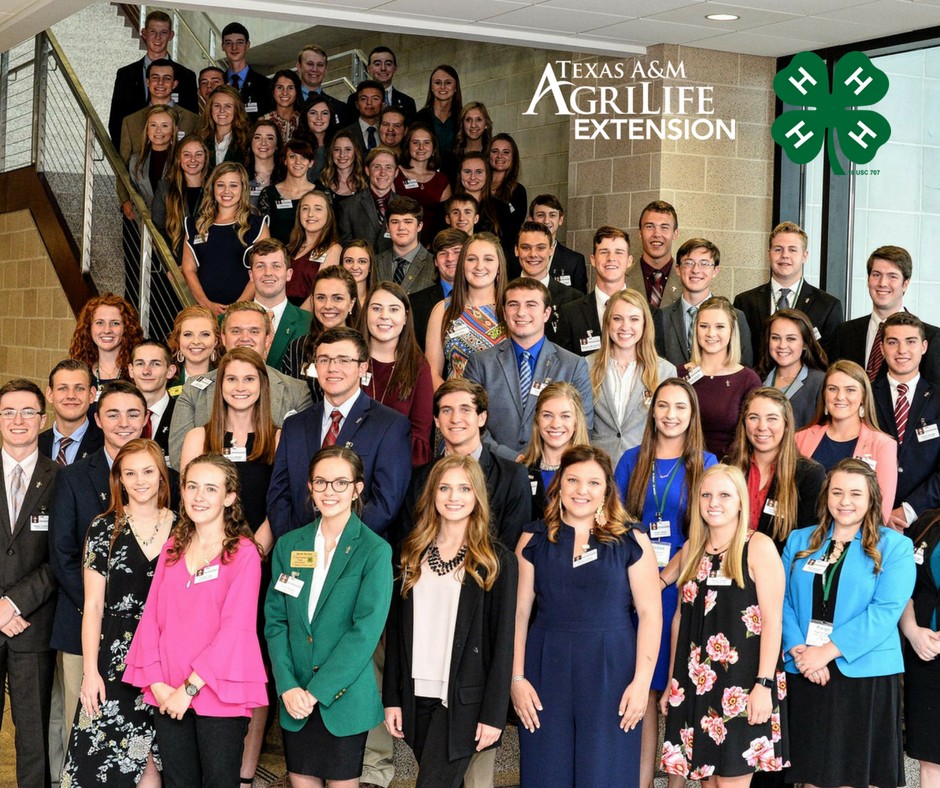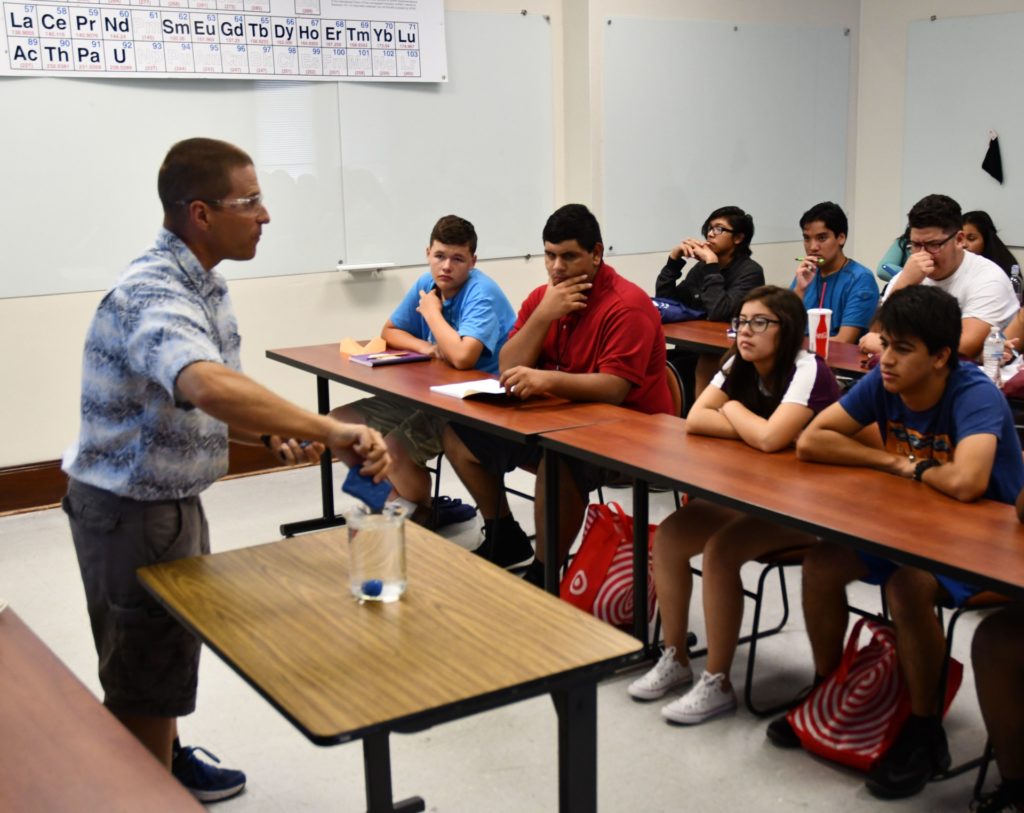Study: Texas 4-H alumni, scholars exceed at postsecondary education
Results show 4-H participants perform well academically, gain marketable skills
A recent study by Texas A&M AgriLife indicates high school graduates who participated in Texas 4-H for at least two years were better equipped to complete postsecondary education and acquired more marketable skills when compared to the general student population of Texas.

The study was conducted as a joint project of the Texas 4-H program of the Texas A&M AgriLife Extension Service and the Department of Recreation, Park and Tourism Sciences in Texas A&M’s College of Agriculture and Life Sciences, Bryan-College Station. It was funded, in part, by the Bradberry Chair endowment and the Sequor Youth Development Initiative, along with the Texas 4-H Youth Development Foundation.
“The nationwide 4-H program has evolved over the years, as has the Texas 4-H program,” said Jeff Hyde, Ph.D., AgriLife Extension director. “While it has continued its rural and agricultural traditions, 4-H has also extended into urban areas and placed additional emphasis on life skills development.
“The 4-H program has also widened the variety of academic interest areas it provides its members, including a number of STEM learning opportunities. The depth and breadth of experiences Texas 4-H provides youth for personal and academic development not only help prepare them for academic success, they also help prepare them for success in life.”
Crunching the numbers
The study population included all students who graduated from Texas public and private high schools in 2013, 2014 and 2015, along with Texas 4-H alumni who graduated during the same years with two or more years of 4-H membership, as well as recipients of Texas 4-H Foundation scholarships. Data for the first group came from Texas Higher Education Coordinating Board, THECB, databases, while data for the second group came from the National Student Clearinghouse.
“We secured records of 4,259 Texas 4-H alumni and evaluated their postsecondary academic performance per the goals set forth by the Texas Higher Education Coordinating Board, in particular their 60x30TX goals,” said Darlene Locke, Ph.D., AgriLife Extension specialist and coordinator the research project in the Recreation, Park and Tourism department, Bryan-College Station.

The study included a subset of 556 Texas 4-H alumni scholars who received Texas 4-H Foundation scholarships from donors such as the Houston Livestock Show and Rodeo, San Antonio Livestock Exposition, Richard Wallrath Educational Foundation and Texas 4-H Youth Development Foundation.
“We had two specific areas of focus for the study,” Locke said. “The first was to find out whether Texas 4-H alumni performed better academically than the student population of Texas in postsecondary education per THECB 60×30 goals. The second was to discover if Texas 4-H alumni were better prepared for postsecondary education entry than the overall student population.”
THECB mission and goals
THECB is the highest authority on matters of public higher education in Texas. Its stated mission is to provide “leadership and coordination for Texas higher education and to promote access, affordability, quality, success and cost efficiency through 60x30TX, resulting in a globally competitive workforce that positions Texas as an international leader.”
The board aspires to achieve a status of 60% of Texans ages 25-34 earning a postsecondary credential by 2030. And its 60x30TX initiative strives for 550,000 students in 2030 to complete a certificate or degree from a Texas college or university. It also looks for graduates to have marketable skills and, upon graduation, incur a debt not to exceed 60% of their first-year’s wages.
Study results and 60×30 goals

The study revealed that 4-H alumni and alumni scholars in the 2013-2015 cohort substantially exceeded THECB goals and the performance of the population of Texas students. Some highlights from this study were:
— 4-H alumni and scholars substantially outperformed the Texas population in four-year completion rate of degrees and certificates. THECB established a goal of 60% by 2030. Yearly targets are in place to monitor progress. The progressive target for the current year is 45%. The population of Texas students fell slightly short of that goal, at 43.6%. In contrast, completion rates for 4-H alumni and scholars were 78% and 88.8%, respectively.
— 4-H alumni and scholars also outperformed the population of Texas students on four-year graduation rates for baccalaureate degrees. Almost 39% of the Texas population completed a baccalaureate degree in four years, slightly below the THECB target. 4-H alumni completed their degrees and certificates at a rate of 83%, and scholars at 89.8%.
— 4-H alumni and scholars also substantially outperformed the Texas population in five-year completion rate for certificates and degrees. The THECB progressive target was 46.4%. The statewide population fell below this target at 43.7%. In contrast, 4-H alumni and scholars’ five-year completion rates were 95.2% and 97.4%, respectively.
— The THECB’s progressive target for acquisition of marketable skills is 100%. The THECB defines marketable skills as either being enrolled in graduate school or employed one year following graduation with a certificate or a degree. The Texas student population rate was 78.5%, while the rate for 4-H alumni was 98% and scholars was 98.1%
— The average ratio of student loan debt to first-year gross income is also monitored by THECB. The progressive target was $0.60 of debt per dollar of first-year income. For this metric, only high school graduates from 2013 were evaluated as data was not available for the other years. Debt of all populations studied was under the THECB target for this metric: at $0.53 for the Texas population and $0.55 and $0.41 for 4-H alumni and scholars, respectively. While the mean debt ratios for 4-H alumni and scholars were less than the Texas population, the difference between them is not statistically significant.
Other aspects of the study
The study also investigated whether Texas 4-H alumni and scholars had higher ACT and SAT scores at entry as well as higher levels of dual-credit enrollment.

“We conducted a supplemental survey to acquire additional data on select facets of academic performance such as ACT and SAT scores, student debt, dual-credit enrollment and marketable skills,” said Gary Ellis, professor and holder of the Bradberry Chair of Youth Development in the Department of Recreation, Park and Tourism Sciences, Bryan-College Station.
Ellis said the survey questionnaire included 19 questions and was administered through an online survey application.
“We received responses from 719 4-H alumni, with 201 of these being 4-H alumni scholars,” he said.
Results from the supplemental survey showed:
— The Texas average ACT composite score for 2013-2015 was 21. The average ACT score for 4-H alumni was 24.59 and 26.59 for 4-H scholars.
— Enrollment in dual-credit courses was higher for 4-H alumni and scholars. While only 14% of the Texas population for 2013-2015 enrolled in dual credit courses, 70% of 4-H alumni and 77.9% of scholars were enrolled.
“Earning dual credit accelerates progress toward degrees and thereby advances the efficiency of the higher education system,” said Montza Williams, Ph.D., statewide Texas 4-H program director, Bryan-College Station. “Although THECB 60x30TX priorities do not include an explicit goal for four or five-year completion, the Texas higher education board monitors graduation rates and considers efficient completion of degrees to be very important.”
Williams said the study and supplemental survey consistently indicate that 4-H alumni and scholars are succeeding in postsecondary education at rates substantially exceeding the overall Texas population in addition to acquiring marketable skills.
Following up on the study
“While the study has a few limitations, we plan to replicate it annually to continually monitor the academic performance of our Texas 4-H members,” Williams said. He said data from each year will be organized into a dashboard format to inform decision-making by leaders of Texas 4-H.
“We envision improving data collection processes each year. The next iteration will include SAT scores, and we will pursue strategies to secure a larger sample size for the supplemental survey,” he said.
Williams also noted a 2019 study of 4-H alumni conducted at the national level by Edge Research showed the students benefitted from the academic and personal development aspects of the 4-H model well into adulthood.
“I believe we are seeing an excellent example of some of those long-term benefits as they apply to Texas 4-H alumni in their postsecondary academic performance,” he said.


